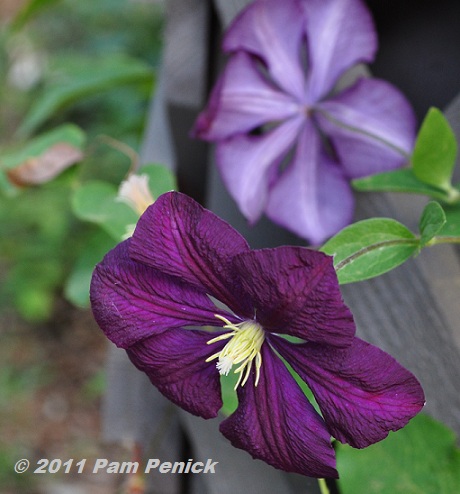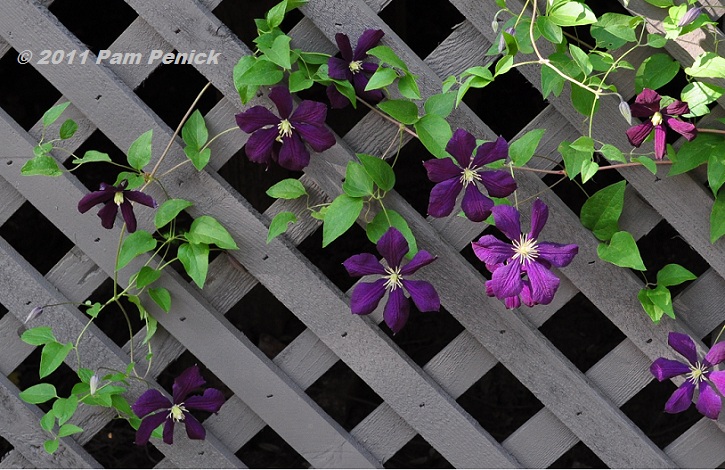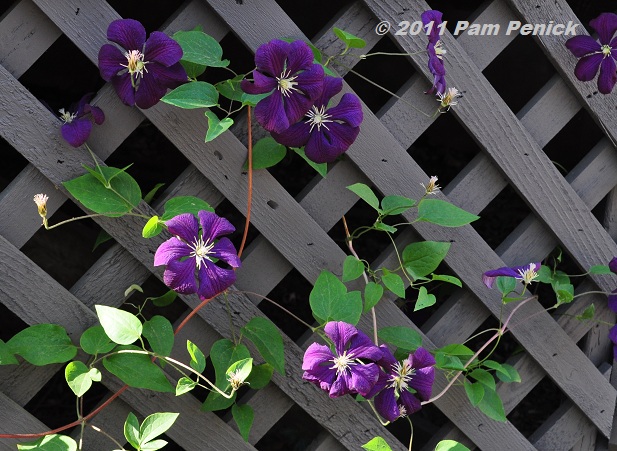Plant This: ‘Etoile Violette’ clematis
A classic garden beauty, ‘Etoile Violette’ clematis has proven hardy in my garden for the past two years through our blazing summers and unusually nippy winters. Its name means Violet Star in French, and its blossoms are indeed star-shaped, large, and open, unlike our native bell-shaped clematis, C. pitcheri, and tough hybrids like ‘Duchess of Albany.’
Mine grows in morning sun and dappled midday sun, with shade in the late afternoon. As with most vines, it likes to have its roots shaded by other plants, and the deck trellis it twines on helps with that too. It receives the same amount of water as most of the rest of my garden: a once-a-week sprinkler system run. Perhaps because of our summer heat, it isn’t a rampant grower, as it can be in more-temperate climates. Mine seems content to ramble along the trellising under the deck, getting to about 8 or 10 feet wide over the course of the season. I direct its growth horizontally rather than encouraging it to grow tall, but I imagine it could be trained to cover a small arbor.
‘Etoile Violette’ is deciduous, and it blooms on new growth, so it needs to be cut to the ground each year for best flowering. I cut mine back in mid-February, and it rewards me with a couple of weeks of delightful flowers each April.
I found ‘Etoile Violette’ clematis at Barton Springs Nursery a couple of years ago. You might want to call around to see who’s carrying it this year.
Note: My Plant This posts are written primarily for gardeners in central Texas. The plants I recommend are ones I’ve grown myself and have direct experience with. I wish I could provide more information about how these plants might perform in other parts of the country, but gardening knowledge is local. Consider checking your local online gardening forums to see if a particular plant might work in your region.
All material © 2006-2011 by Pam Penick for Digging. Unauthorized reproduction prohibited.





That is stunning! I’m going to have to break down and buy (or have DH build) a trellis for an “Etoile Violette” of my own.
Or just train it up a fence with thin wire strung between galvanized eye screws. Simple! —Pam
My fav in Michigan was Niobe. Oh, how I loved her rich velvetly deep burgundy petals. We may have moved before she hit her third year. So much I miss about that garden.
I kept attempting Henrii, for that snappy white always bewitched me, but he never stayed around long.
It can take a few years of experimenting to find the clematis that works best for one’s region, can’t it? In your new arid climate, do you find any that work for you? If not, there’s pretty little snapdragon vine, which I love. —Pam
It’s lovely and looks so nice against the gray lattice. I have a few Jackmanii that are just starting year 2 and they have some green growth, but are still pretty sparse. I hope for the day when they look nice like yours.
‘Jackmanii’ is pretty too. I hope it fluffs for you soon. —Pam
Very pretty and romantic.
Yes, it is that. —Pam
Pretty, pretty, pretty. I will have to keep an eye out for that one.
I hope you can find it, Caroline. If not, it sounds as if ‘Jackmanii’ is a good substitute. —Pam
I love all clematis!! This is a great shade of purple.
I love clematis too, Darla, but for years thought the large-flowered varieties didn’t grow that well in Austin. I’m happy to discover some that do. —Pam
I have seen this one for sale around here but I have Jackamanni which to me looks so similar. Jack is a great worker for me. I have divided and sprinkled it around my garden.
I hadn’t thought to divide a vine, Lisa. I’m glad to know it can be done. —Pam
That is a great purple – we can even grow decent clematis in the high desert areas…with deep soil, E exposure and regular water. Worth it in a small area where the above can be supplied!
Yes, such indulgences are worth it from time to time. —Pam
To my eye, this gives Jackmanii a real run for its money. I had fairly good luck with clematis in NW Oregon, where I gardened until ten years ago: less so here in Colorado. But I think I’m going to look around for this pretty thing.
I hope it works out for you, Patricia. —Pam
I’ve grown it for years and it is a very reliable clematis, even for Southern California.
Good to know! —Pam
Sorry, a bit tangential, but about your once-a-week sprinkler system run: how long do you run the sprinkler? And do you still do just once a week at the height of summer? As a Texas newbie, I’m still trying to figure out watering, and I always seem to be erring on one side or another.
Melody, figuring out a watering regimen is a tricky business, and what your garden needs may vary greatly from mine depending on how much sun it gets, the porosity of your soil, the kind of plants you have, whether you use mulch, how new your garden is, how large your sprinkler system zones are, etc., etc. You’ll have to experiment to find the right amount, and that will likely change at different times of the year. For instance, I don’t turn my sprinkler system on at all in the winter (unless it’s exceptionally dry, and then I’ll run it once a month, maybe). And even in summer I turn it on manually once a week (on my city-mandated watering day) so that I stay aware of how much I’m watering. For the record, I run each of my sprinkler zones for 15 or 20 minutes to give a deep soaking. If it’s been really dry, I run each zone for 5 minutes to “wet the sponge,” so to speak, and then run it again for another 15.
If you have a new garden, err on the side of watering more often through the first summer, especially as we’re in for another drought. If your garden is established, try watering once a week (or even every two weeks if it’s a shady or drought-tolerant garden) and stroll through it each morning to observe whether any plants are wilted first thing in the morning. If so, stick your finger in the soil to see if it’s dry. If it is, and the plants are wilted or shriveled, you need to water. If the plants seem fine, see if you can get to the next watering day without stressing your plants.
If you’re using a hose-end sprinkler, put out an empty tuna can and water until you see two inches of water in it. Watering deeply but infrequently encourages your plants to grow deep roots. Again, this is for established gardens. Brand-new gardens may need more water, especially in the first summer. —Pam
That’s a beauty…I’ll keep it in mind as we search for some vines to cover our new fence 🙂
I have a clematis I bought from one of the Desert Botanical Garden sales (spring and fall, they have them)
It has yet to bloom, but I’m keeping a close on it this year. I think I finally found a place to site it where it seems happy. We’ll see.
Thanks so much, Pam, for the thorough response. SO helpful! I think I’ve been way overwatering, so I’m going to cut back and see how things go. I really appreciate it.